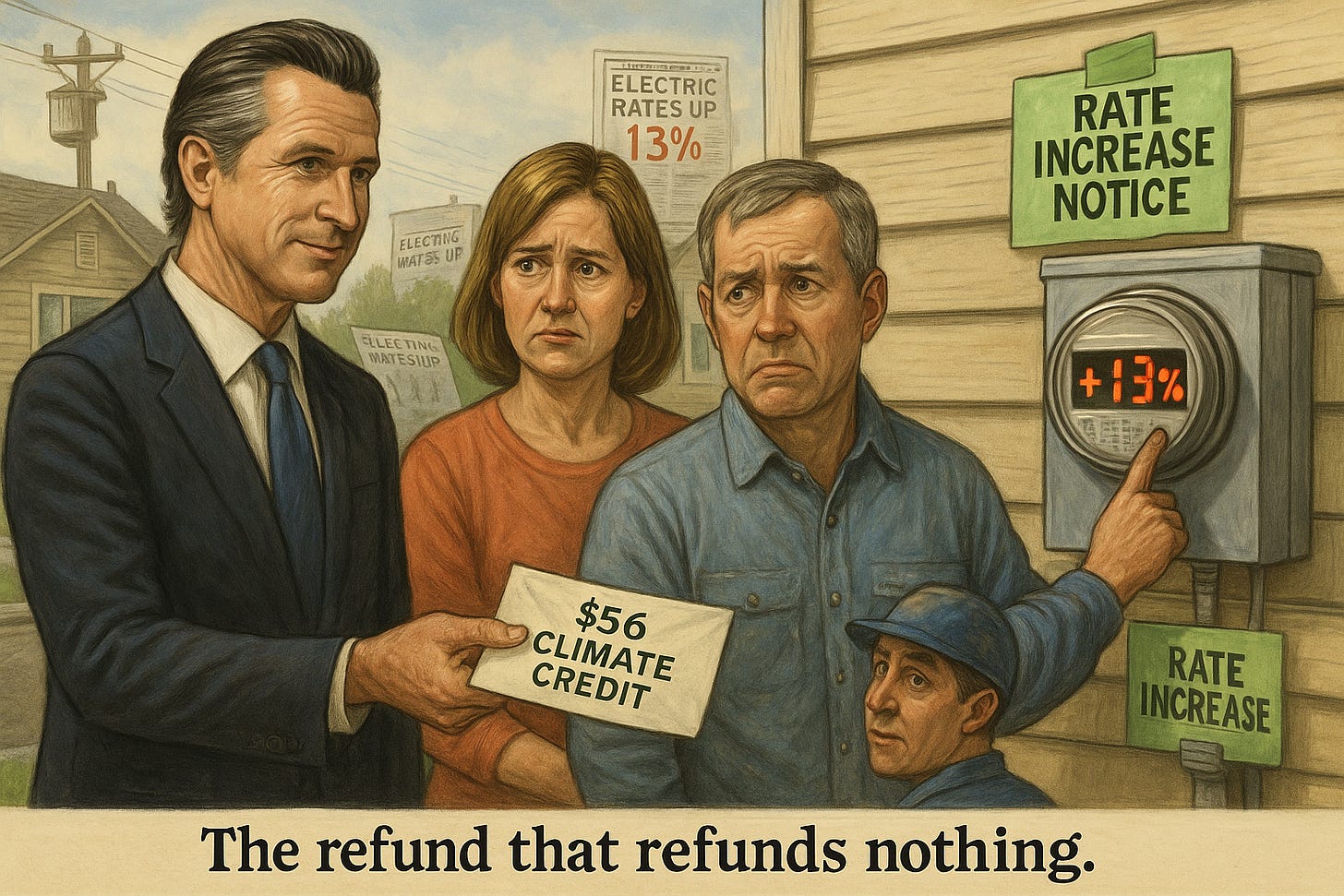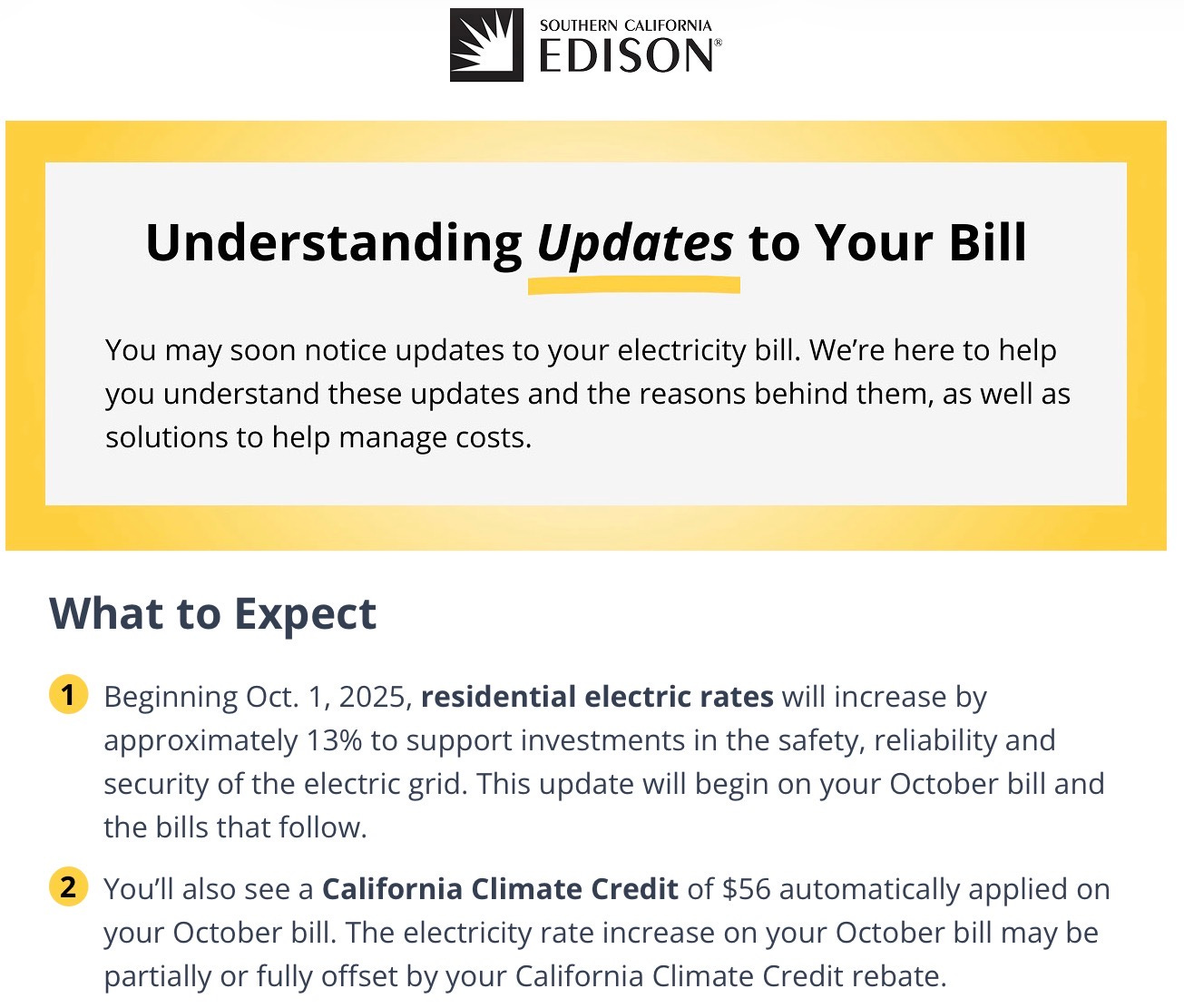Gavin Newsom’s Costly Carbon Quest: Billions in Mandates, Pennies in Global Impact
The 2025 extension of CA’s cap-and-trade program will cost utilities hundreds of millions annually, with SCE’s 13% rate hike adding roughly $200–$300 per household per year beginning this month.
🕒 4.5-minute read
Typically our afternoon columns are for paid subscribers, but on Friday afternoons we are more lax, as we try to show free subscribers what they can get with an upgrade!
The Sting of the Latest Rate Increase
I just received a notice from Southern California Edison announcing a 13% hike in electricity rates. They cite grid maintenance and wildfire prevention, but the fine print reveals another driver: “green compliance” costs tied to Governor Gavin Newsom’s aggressive carbon-reduction mandates.
Under his leadership, California has doubled down on policies forcing utilities to buy carbon credits, invest in renewables, and overhaul infrastructure. While I live in SCE’s service area, no doubt customers of Pacific Gas and Electric, San Diego Gas and Electric, and other utilities face similar increases.
These costs hit families hard, forcing choices between keeping the lights on and other essentials.
Unpacking the Folly of Single-State Climate Ambitions
California’s single-state war on human-produced carbon emissions is a textbook example of misguided policymaking. From Sacramento, lawmakers chase unattainable climate targets, imposing measures that hurt residents while achieving little globally.
The state’s cap-and-trade program, electricity taxes, and regulatory overreach push costs onto the very people least able to pay and exacerbate the housing crisis.
Billed as a market-based fix, cap-and-trade has become a bureaucratic maze. It caps emissions and lets companies trade allowances within that limit—essentially a hidden tax that trickles down to consumers.
In 2025, allowance prices have ranged from $26–$29 per ton, adding roughly 23–26 cents per gallon of gasoline and increasing electricity and heating bills. Small businesses drown in compliance costs while large corporations game the system.
The climate impact is negligible: California produces less than 1% of global CO2, and zeroing out those emissions wouldn’t shift global trends while China continues approving about two coal plants a week. Yet policymakers cling to symbolic gestures that produce real-world harm.
At 32 cents per kilowatt-hour, California’s 2024 residential electricity prices are about double the national average. Mandates for wind and solar—which require costly grid upgrades and backup storage—plus the phase-out of natural-gas plants, have pushed reliability to the brink.
The 2020 heat wave caused blackouts; in 2022, only emergency actions prevented another.
It’s low-income households that bear the brunt: by late 2024, about 1 in 5 families statewide were behind on electric bills (rising to 1 in 4 in some service areas). A balanced approach would prioritize reliable power, but California’s leaders continue forcing working families to underwrite expensive green experiments.
The Regulations Fueling the Fire
These rate hikes didn’t come out of nowhere. They stem from a layered set of state mandates that put carbon goals ahead of affordability. Here are the major drivers of rising energy costs for all Californians—ironically, from a legislature that calls itself progressive:
Global Warming Solutions Act (2006)
Requires statewide greenhouse-gas emissions to return to 1990 levels by 2020.
💰 Cost impact: Laid the foundation for cap-and-trade and other compliance programs. Utilities had to buy carbon credits, upgrade reporting systems, and fund regulators—all costs passed to ratepayers.
Cap-and-Trade Program (2013 → extended in 2025 through 2045)
Utilities, fuel suppliers, and large emitters must buy allowances for each ton of CO2 they release.
💰 Cost impact: Recent auction prices around $26–$29 per ton add hundreds of millions in annual compliance costs. Utilities recover these through electric- and gas-rate pass-throughs.
Emissions Performance Standard (2006)
Prohibits utilities from long-term contracts with plants emitting more than 1,100 pounds of CO2 per megawatt-hour.
💰 Cost impact: Effectively ended coal imports and forced replacement with cleaner but higher-cost natural-gas and renewable contracts, plus new grid-connection expenses.
Renewables Portfolio Standard (RPS)
Requires utilities to deliver 44% renewable electricity by 2024, 52% by 2027, and 60% by 2030.
💰 Cost impact: Renewable generation and backup storage, along with new transmission, raise system costs. State planners estimate $39–$54 billion in transmission investment over the next two decades to meet integration needs.
100% Clean Electricity Policies (2018 / 2022)
SB 100 (2018) mandates 100% clean power by 2045; SB 1020 (2022) adds interim goals of 90% by 2035 and 95% by 2040.
💰 Cost impact: Drives massive investment in renewable generation, large-scale energy storage, and new transmission lines—costs utilities fully recover from consumers through higher rates.
To make matters worse, right below this notice of a massive rate hike is a “courtesy” note about a $56 one-time California Climate Credit—hardly enough to cover even a month’s increase.
These policies generate costly and damaging consequences. Utilities must comply by pouring billions into solar farms, wind turbines, and battery systems that depend on federal tax credits and guaranteed cost recovery. The result? Higher rates that hit lower-income households hardest.
And for what? California’s emissions are an almost invisible share of global emissions, yet we pay premium prices as if we’re saving the planet. Above is the “explanation” for the rate hike in the SCE notice.
So, Does It Matter?
What’s missing most in California policymaking is prudence. These escalating costs matter because they erode the financial stability of millions of residents.
Rising utility bills force painful choices—cutting groceries, delaying medical care, or moving out of state. These aren’t just numbers—they represent real people carrying the burden of policies that deliver marginal environmental benefit.
Governor Gavin Newsom and his allies in Sacramento may champion these measures as visionary, but California needs balance: reliable energy, affordability, and realistic sustainability. Without it, California’s green ambitions risk leaving its residents literally and financially in the dark.
It’s time to demand accountability—and ensure environmental goals don’t crush the very people they claim to protect.
SEMPRA’S LEAD LOBBYIST TALKS ABOUT IMPRUDENT POLICY MAKING COMING OUT OF SACRAMENTO
This morning as I was working on this column I got a notice that the latest State of Gold Podcast had dropped. This one is with the in-house head of legislative lobbying for Sempra Energy, Mitch Mitchell. He does NOT go into the folly of the climate change policies because to these liberal legislators who treat this area of policy like a religion, to be publicly critical would be to lose your ability to, as I put it, lobby at the margins. Like all State of Gold interviews, it’s worth watching. The host, Jon Slavet, does a great job with these.







Thank you for the analysis. I am a lifelong Californian. Gavin Newsom has destroyed my state.